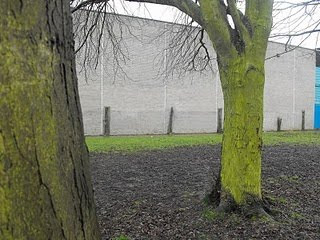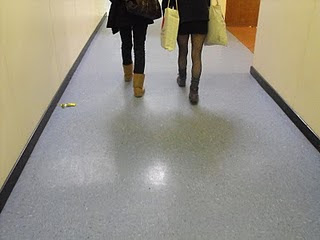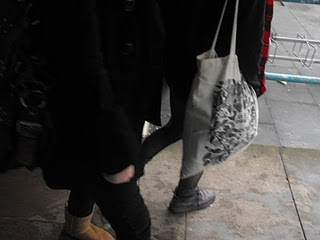Shot 1 : The first opening shot is of a black screen which connotes the beginning of the film. The use of black suggests danger and mystery as of what is to come. A production title may be included in this shot.
Shot 2 : Is a point of view shot from behind a tree, this is to suggest that someone is lurking there in order to spy/stalk the other characters we are planning to use. This automatically creates questions as to who the person behind the tree is and as to why they are there. In terms of sound, i think it will be silent, although there may be some form of scratching sound or music that is of a thriller genre. A long shot will prove more effective in terms of creating a realistic point of view shot.
 Shot 3 : A medium shot of the two characters who will be police officers/detectives and of which we are hoping to include partial dialogue to represent that in their field of work there is an unsolved multiple muder case in which they are discussing certain aspects. This is to connote to the audience that a killer is on the loose, and point of view shot that it will be filmed with shows that the murderer is listening in on them, both characters unaware.
Shot 3 : A medium shot of the two characters who will be police officers/detectives and of which we are hoping to include partial dialogue to represent that in their field of work there is an unsolved multiple muder case in which they are discussing certain aspects. This is to connote to the audience that a killer is on the loose, and point of view shot that it will be filmed with shows that the murderer is listening in on them, both characters unaware.
Shot 4 : Is of a door, which will lead to an office or business room to show the killer is actually in the police force himself. Although this is a medium/long shot of a door, i think a close up of a door with a production title or name on it will prove more effective.
Shot 5 : A medium/close up of the two detectives walking away from the building, still no focus on their faces as to convey a sense of 'anonymity' again and to keep the focus on just the dialogue, an important basis to the film opening plot.

Shot 6 : Cuts to another black screen, used to connote a sense of fastforward time, a convention often used in films to show this and to confuse the audience as to what is going to unfold. This shot may also include another title for a production company or a name of a character, in effect invloving the title and opening sequence together.
Shot 7 : the black screen fades to a back shot of the main male characters head, hiding his identity (this is why i think Anonymity is a good name due to the fact that we never actually get to see the killer or any other characters in order to create a sharper focus on the surroundings and other filmed aspects. This shot will shot the character at his desk in his office, again to prove he is the killer which no one suspects, and is a medium close up shot. The shot will be quite dark, suggesting it is nightfall, creating an almost eerie quality to it.
Shot 8 : Cuts to another black screen, providing as a device to begin the montage of shots in which parts of the killers motives will be revealed. This shot may include titles however i think it will be more effective if it is left just completely black as to connote that it is different to the other black screen which we have used. The music as this point will change to that of a sharper, quicker and non diegetic sound which was not previously heard, also to convey that the direction in which the film was heading has changed, invloving a series of flashbacks aswell as current aspects which will continue to disorientate the audience.

Shot 9 : The black screen then cuts rapidly to a close up shot of a smashed picture frame on a hard surface floor to show an act of violence has lead to the breaking of the frame. The picture it holds will be of a family; a man with his children, connoting the man in the photo may be the killer, and provides questions as to what has happened to the children and the happy time it holds. The non diegetic music continues.
Shot 10 : Will be the main character typewriting, or will show extreme close up of the typewriter letters in order for the auidence to work out that he is planning his next murder. Along with the non diegetic music, the ambient sound of the typewriter will be heard.
Shot 11 : Another extreme close up showing a cutting instrument, either scissors or a blade showing the faces have been cut out in a photograph of another family.
Shot 12 : A black and white shot of a canal at night will provide as a flashback from the main characters' mind where a shot of the character himself will be seen standing by the water, looking suspicious. The non diegetic music stops and the sound of the killers hearbeat/breathing will be used to convey a sense of urgency and danger.
Shot 13 : The picture used here will be the same used for shot 14, however when filming, a jump cut will be used from the main character standing by the canal to a shot of him standing over what appears to be a dead body, with the prop of a dry cleaning bag for the same look as a body bag.
(Shot 14 : This picture will be used twice in the storyboard, but in filming it will be of the main character standing over a dead body.) The jump cuts will show the man dragging the body.
Shot 16 : A close up of the water in the canal, connoting that the dead body has been placed in the water, in order for the killer to cover his tracks. After this shot, the sound of the killers hearbeat/breathing will cease and the non diegetic music of before will start again, we may decide to add the sound of a splash to convey the body being put into the water.
Shot 17 : Is a close up of a sink, the image will still be in black and white, and the audience will see what looks like blood pouring down the sink, another convention of thriller films that we find effective. The use of black and white shots will enable us to use an ink or food colouring in order for it to look like blood, something that, for me, was influenced from the film Psycho, with the infamous shower scene.
Shot 18 : For this close up shot, hannah used a post it pad as a prop for a police badge which we are intending on using. This will indicate once again that the murderer is in the police force, right under his collegues noses.
Shot 19 : Shows the man taking the picture out of the smashed frame. It will hopefully show that this photo means something to him and is of importance. The smashed glass will make it look more effective and as said in the risk assessment, it will be controlled in order to make sure no one is harmed. The hands of the character will be shaking and frantic to create anxiety.
Shot 20 : This overhead shot will show the typewriter again to build up tension, with the non diegetic music dying down for the sound of the typewriter to be gradually grwoing louder and louder. This will cause more tension.
Shot 22 : will be a black screen showing the film's title Anonymity in the font, i think, of the typewriter, to make it look more genuine and realistic. This will prove as the ending of the title sequence. The black screen however, isn't a fully black screen, it will be a pitch black room...
Shot 23 : The ultimate shot will bring the opening sequence to a close and is perhaps the most significant. In the pitch black room, the light from a flashlight will uncover a wall containing mis-mathced photographs of families, and the disturbing factor will be that the faces will all be cut out. All will be silent and the only sound will be the breathing of the main character.
















No comments:
Post a Comment